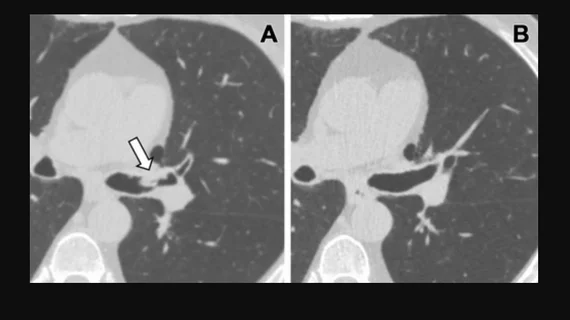Lung-RADS update helps limit false-positive results, unnecessary procedures
A comparison between Lung Imaging Reporting and Data System (Lung-RADS) version 1.1 and Lung-RADS version 2022 found the newer version helped reduce the number of false-positive screening CT examinations while still identifying malignant airway nodules. The study from Brigham and Women's Hospital, recently published in Radiology: Cardiothoracic Imaging, demonstrated the improved diagnostic accuracy of version 2022, which may lead to a decrease in unnecessary interventions such as bronchoscopy.[1]
The authors retrospectively analyzed all patients who underwent CT lung cancer screenings (LCS) in three centers between 2015 and 2021 and had a reported airway or endobronchial nodule. A total of 9,068 patients underwent 21,954 lung cancer screening CT examinations during this period. Of these, 174 patients were identified with true endobronchial nodule finding, 6% of which were malignant. Both versions of Lung-RADS provided comparable sensitivity (91% for both) in identifying malignant nodules in patients with at least one airway nodule. However, Lung-RADS version 2022 had improved specificity compared with Lung-RADS version 1.1 (82% vs. 50%) and led to reclassifying 52 false-positive studies as true-negative.
Lung-RADS was developed by the American College of Radiology to standardize reporting and management recommendations for LCS. The earlier version classified endobronchial nodules as suspicious lesions, but with was revised in the new Lung-RADS version 2022, which revised criteria for these nodules to include factors like location and stability or growth.
"In analyzing the risk of lung cancer based on airway nodule characteristics, we observed that nodules located in the trachea and mainstem bronchi were consistently benign. Multiple airway nodules were also more likely to be benign," the researchers concluded. They also noted all 11 of the malignant airway nodules demonstrated obstructive morphology.
The study highlights the importance of assessing airway nodule characteristics for risk stratification. The researchers said the updated Lung-RADS version 2022 provides an improved classification system.
The study was also the subject of a research highlight published in Radiology: Imaging Cancer.[2]

